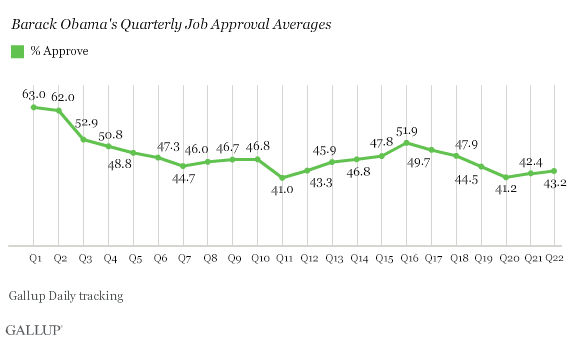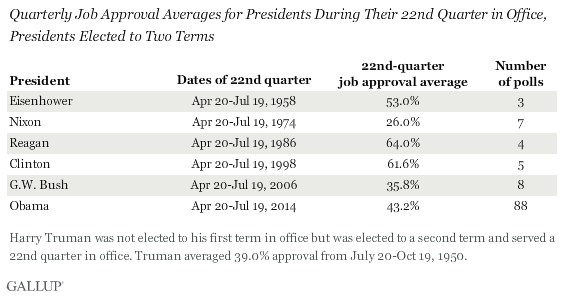PRINCETON, NJ -- President Barack Obama averaged 43.2% job approval during his 22nd quarter in office, from April 20 through July 19. That is a minimal increase from the prior quarter's 42.4% average, but still ranks among the lowest for Obama to date. His worst quarterly average thus far is 41.0% in quarter 11.

Obama's 22nd quarter was largely characterized by remarkable stability in his job ratings, which ranged narrowly between 43% and 45% each week throughout April and May into early June. His job approval showed a notable dip to 41% in mid-June, about the time Islamic militants took control of major portions of Iraq. His approval has recovered slightly since then, averaging 43% last week, but has yet to get back to 44%. His late-quarter slump prevented slightly greater improvement in his overall 22nd-quarter average.
Obama is the sixth twice-elected president since World War II to serve 22 quarters in office. His 22nd-quarter averages are lower than those of three other presidents -- Dwight Eisenhower, Ronald Reagan, and Bill Clinton -- and higher than those of two others, Richard Nixon and George W. Bush. Nixon's 22nd quarter was his last full quarter before he resigned in August 1974 because of his involvement in the Watergate scandal and the mounting threat of an impeachment vote in the House of Representatives.

A seventh post-World War II president, Harry Truman, served a 22nd quarter in office, though he was not elected to his first term. During that quarter, from July to October 1950, when the U.S. was fighting the Korean War abroad and dealing with a struggling economy and McCarthyism domestically, Truman's average job approval was 39%.
All of these presidents' 22nd quarters in office occurred with the second midterm elections of their presidencies looming. Historically, the president's party typically suffers heavy losses in the House in the second midterm. But Clinton's and Reagan's relatively high popularity likely helped mitigate midterm seat losses for their parties in the elections.
In 1998, the Democrats bucked the historical trend and gained seats in the House of Representatives, at a time when Republicans were undertaking efforts to impeach Clinton in the aftermath of his affair with a former White House intern. In 1986, Republicans lost only a small number of House seats. However, Republicans did lose enough seats in the Senate that year to yield partisan control to the Democrats.
Obama's approval rating is unlikely to improve much before the 2014 midterm elections, based on history. Eisenhower, Clinton, and Bush saw modest improvements in their 23rd-quarter ratings of between two and three percentage points, while Reagan saw a modest decrease. Reagan's 22nd-quarter average proved to be the high-water mark of his presidency.
Although Obama's lower job approval rating does make Democratic candidates vulnerable this fall, it is not clear from a structural perspective how many more seats Republicans could gain in the House after they gained more than 60 in the 2010 midterms. Obama's unpopularity is likely to be a greater factor in the Senate elections, as Democratic Senate incumbents elected in a strong Democratic year of 2008 must face re-election this year in a much less favorable election environment for them.
Implications
The relative stability in Obama's job approval ratings can be looked at both from a glass-half-empty and a glass-half-full perspective. On the negative side, his ratings are not increasing much despite an improving economy. On the positive side, they have held steady despite a series of challenging events during the last quarter, including the controversy about medical care for military veterans at Veterans Affairs hospitals, the prisoner exchange with the Taliban, the Iraq situation, and the crisis of illegal immigrant children from Central America crossing the U.S. border.
At a similar point in his presidency, George W. Bush's support had eroded to mostly below 40% in the face of a series of second-term challenges including the war in Iraq, Hurricane Katrina, and the failed nomination of Harriet Miers to the Supreme Court.
Obama may be able to keep his ratings above the 40% mark as long as he maintains strong levels of support among Democrats. Although Democrats' approval ratings of Obama are down from earlier in his presidency, they still consistently approach 80%.
Explore President Obama's approval ratings in depth and compare them with those of past presidents in the Gallup Presidential Job Approval Center.
Survey Methods
Results for this Gallup poll are based on telephone interviews conducted April 20-July 19, 2014, on the Gallup Daily tracking survey, with a random sample of 44,622 adults, aged 18 and older, living in all 50 U.S. states and the District of Columbia.
For results based on the total sample of national adults, the margin of sampling error is ±1 percentage point at the 95% confidence level.
Interviews are conducted with respondents on landline telephones and cellular phones, with interviews conducted in Spanish for respondents who are primarily Spanish-speaking. Each sample of national adults includes a minimum quota of 50% cellphone respondents and 50% landline respondents, with additional minimum quotas by time zone within region. Landline and cellular telephone numbers are selected using random-digit-dial methods. Landline respondents are chosen at random within each household on the basis of which member had the most recent birthday.
Samples are weighted to correct for unequal selection probability, nonresponse, and double coverage of landline and cell users in the two sampling frames. They are also weighted to match the national demographics of gender, age, race, Hispanic ethnicity, education, region, population density, and phone status (cellphone only/landline only/both, and cellphone mostly). Demographic weighting targets are based on the most recent Current Population Survey figures for the aged 18 and older U.S. population. Phone status targets are based on the most recent National Health Interview Survey. Population density targets are based on the most recent U.S. census. All reported margins of sampling error include the computed design effects for weighting.
In addition to sampling error, question wording and practical difficulties in conducting surveys can introduce error or bias into the findings of public opinion polls.
For more details on Gallup's polling methodology, visit www.gallup.com.
